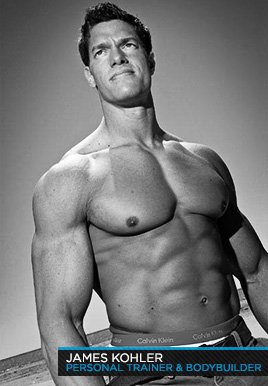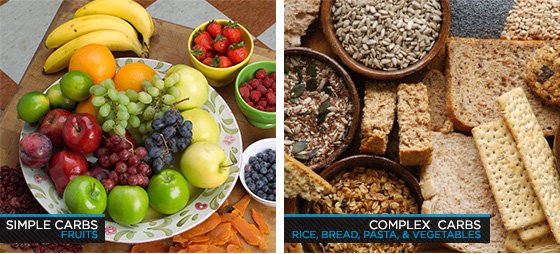Not only is it important that we make good food choices, but it is essential that we monitor our daily caloric intake as well. There is no rocket science involved in how to lose weight.
It's very simple and it works like this: If you consume more calories than you burn you are in a "positive energy balance." When you are in a positive energy balance you will store the extra energy as fat, no matter what source the energy is from- protein, carbohydrates, or fat.
On the contrast, if you expend more than you intake (a negative energy balance), weight loss occurs. If they are equal, weight is maintained.
Calories In - Calories Out
Calories provide fuel your body needs to function, whether it's from protein, carbohydrates, or fat. Each day you expend a certain amount of energy based off or your metabolic rate and by doing daily activities. This energy is fueled from the calories you consume or breaking down energy stores— such as fat. Therefore, the more active you are the more calories you will burn.
Your resting metabolic rate (RMR) usually accounts for about 60-70% of daily expenditure of calories. Energy to maintain cardiac function, neural function and repair the body's cells and structures are included in your RMR. In addition, the more muscle mass you have, the higher the RMR—so you will burn more calories.
BMR Calculator
Other factors contribute to the total calories burned such as; total body mass, body temperature, thermal activity of eating and supplements, and synthesizing protein into new muscle.
These caloric fueled activities can come from any type of food sources. You could eat 6 tbsp or pure lard each day and lose weight, because you would be expending more calories than you were consuming. It doesn't matter what the source is. It boils down to simple math—calories in and calories out. Now I would not recommend anyone have lard as their nutritional source, the point is that calories cause you to gain or lose weight.

So that means if you want to lose weight, your strategy should be to limit your caloric intake and engage in physical activities to burn additional calories. You need to make a calorie deficit, but in a healthy manner. You still need to eat from all of the five food groups so your body can function properly and you remain healthy.
The FDA recommends a daily recommended value (DRV) of 10% protein, 60% carbohydrates, and 30% fat (10% of that being saturated). Additional protein intake has been established for special groups, such as athletes. These recommendations are for sedentary people that don't exercise nor are trying to build muscle. I recommend a balanced diet that consists of 40% protein, 40% carbohydrates, and 20% fat.
Other committees and organizations suggest lower and higher amounts of protein, as high as 70 percent. I believe neither approach would be successful. You need a sufficient amount of protein to build muscle and recover from you workouts. However, an excess of protein can put an unhealthy strain on your liver and kidneys. Not only that, but whatever your system cannot process will be stored as body fat.
The key thing to remember about losing fat is that calories are the primary factor. If you expend more calories than you consume, you lose weight—it's as simple as that.
The Variable - Carbohydrates
"Carbohydrates" is nothing more than a fancy name for sugar. This may sound confusing, but the end result of a baked potato and a spoon of sugar are the same—glucose. When both are processed in the body, the final result is the same—they both are broken down into glucose. Glucose is the body's best source of energy.
The only energy source for the brain and nervous system is glucose, unlike the muscular and skeletal systems. In addition, carbohydrates (glucose) are the body's most immediate energy source, having a 30-50% faster rate of breakdown compared to fat. Anaerobic exercise relies exclusively on carbohydrates. Carbohydrates also have a protein sparing effect, which keeps the body from burning protein for energy.
Forms Of Carbohydrates
Carbohydrates come in essentially two forms, simple and complex.
Simple: Simple carbohydrates are mono and disaccharides or "sugars." Fructose (the naturally occurring sugar in fruit), sucrose (table sugar), and lactose (the naturally occurring sugar in dairy products) are some examples of simple forms.
Complex: Complex carbohydrates are things like potatoes, pasta, rice, bread, and vegetables such as corn (carbohydrate powders are derived from corn). These carbohydrates are polysaccharides or "starch." They contain long chains of more than 3,000 glucose molecules linked together.

Converting Carbs To Energy
Regardless of the form (except fibers), the body converts carbohydrates to energy, glucose. The main difference between simple and complex carbohydrates is the time it takes for the body to convert them into glucose.
Complex carbohydrates tend to give a more gradual and sustained energy release. Where as simple carbohydrates give a sharp energy increase usually accompanied by a sharp decline in energy as well.
One thing to realize is that once the carbohydrates you have eaten have been converted to glucose, what is not used to fuel body functions and replenish muscle glycogen is shuttled into fat stores. Unused carbohydrates will make you fat. Your primary goal with carbohydrates is to provide enough energy to fuel body functions and muscle activity each day and no more. So the variable is carbohydrates, if protein and fat intake remain the same each day.
Carb Cycling
Carb cycling is a dieting strategy a lot of bodybuilders use in order to prepare for a competition. This tactic can also be used for anyone who is looking for an effective way to shed body fat. When your intake of carbohydrates is low, your body is forced to use stored body fat for energy. On the contrast, when your body has been given plenty of carbohydrates—it uses them as the source of fuel rather than fat.
The body does require a certain amount of carbohydrates to simply carry on basic processes—such as for the brain and nervous system. I would not recommend going much lower than 100 grams of carbohydrates per day for this reason.
If your diet is too low in carbohydrates, your workouts are going to suffer. Anaerobic activity is fueled by carbohydrates. In addition, you can enter a state of ketosis.
Ketosis
Ketosis is a state of carbohydrate deprivation and should be avoided. Ketone bodies are the product of the incomplete burning of fats. When these are present in the blood your body does not have enough carbohydrates available in order to properly metabolize body fat. So in other words, you need carbohydrates to burn body fat. The body can use ketone bodies in place of glycogen for energy production, but they are not nearly as efficient in fueling exercise.
When you are in a state of ketosis, you become irritable, sluggish and may become dehydrated. Without carbohydrates available in the body, your body breaks down protein for additional energy (state of catabolic). Your body will actually metabolize muscle tissue for energy at about the same rate as fat if you do not have a high enough protein intake.
Your hard-earned muscle will be metabolized; this is obviously counterproductive for someone trying to build or maintain lean muscle mass. Be sure to take the protein requirements I have outlined above for this reason.
Proper Carb Cycling

The correct way to carb cycle is to make sure you are taking an adequate amount of protein and not limiting your carbohydrates to the point of ketosis. The best way I have found to do this is to follow a plan that consists of three low-carb days and one high-carb day. You continue to cycle the days until you reach your desired goal.
The high carb days are important to have for a few reasons. One, it throws your metabolism off and tricks your body into thinking it came off the diet. If you continue to have low carb days, your body will eventually adapt to this and slow it's metabolism down to compensate for the lower caloric intake. This is known as homeostasis, your body trying to maintain a balance. Having a high carb day "fools" your body. However, after a longer period of time—your body will adapt to this as well.
Another reason to have high carb days is to replenish your glycogen stores. Glycogen is the body's storage form of carbohydrate found in the liver and muscles. Since glycogen is combined together with water, the extra volume in the muscle cells causes the muscles to appear larger. Muscles deprived of glycogen are small and flat and muscles full of glycogen are big and full. I'm sure everyone would prefer the latter.
The last reason to have high carb days comes from a health standpoint. After following a strict low carb diet for three days straight, you can become mentally and physically drained. For this reason, your body should have a break from the routine every fourth day. After that day, you will again feel full of energy, more alert and ready to go into the next three days.
Reevaluating Progress
After doing the carb cycling for 4-6 weeks, you should reevaluate what progress has been made. If you are getting close to your desired body fat, you may want to cut back to two low carb days and one high carb day. This can be done for another 4-6 weeks and then you could even alternate low carb and high carb days.
The best measure is how you look in the mirror and how you are feeling. The scale, tape measure, and body fat percentage can only say so much.
I have outlined a sample low carb day and high carb day that can be used. If you get hungry in the middle of the night, I would suggest having a scoop of protein to hold you over until morning. Carbohydrates are the variable when it comes to fat loss. After you get to your desired goal, you can follow more general guidelines that will become apart of your lifestyle.
